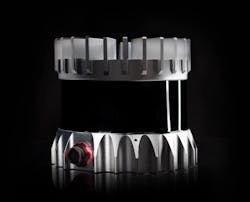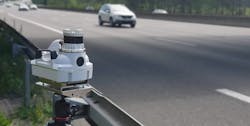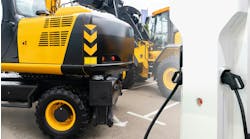Light detection and ranging, better known as lidar, sensors detect ranges by measuring the time it takes reflected light to return to the receiver. This capability makes them a vital component for object detection, mapping and a variety of other use cases in a range of applications.
Historically, lidar has been an analog technology, said Angus Pacala, CEO of Ouster, in an interview with Power & Motion. But like other sensing technologies such as cameras or accelerometers, digital versions are entering and transforming the market. Ouster was founded in 2015 to bring digital lidar technology to the market.
“We've taken analog lidar and integrated all of that capability onto a CMOS digital chip, [which is] a fantastically complex but low cost, power efficient, and incredibly small digital chip that does everything that a traditional analog lidar does,” he said.
This brings a range of benefits including a reduction in cost and form factor. “All the things you associate with digital technology are being brought to lidar in essence.”
Key Benefits of Going Digital
According to Pacala there are three key benefits to digital lidar technology like Ouster’s versus analog versions:
- affordability,
- performance,
- and flexibility.
The affordability benefit comes from the fact a complex system is integrated into a single silicon chip. Thousands of discrete analog components are put onto a single chip which combines “all of the logic and intelligence of an analog lidar sensor into the digital logic on that chip, and all the photo sensing and pixels as well,” explained Pacala.
He equated it to the transition from film to digital cameras – instead of a large, expensive camera containing several components digital versions are tiny devices integrated into every smart phone for a minimal cost. Essentially, he said it is affordability through simplification.
Also benefitting affordability is the fact silicon chips are a high-volume, low-cost technology. Silicon CMOS (complementary metal oxide semiconductor) chips are used in so many applications today, every phone and every digital camera, and thus produced at an extraordinarily high scale with trillions manufactured every year said Pacala.
Flexibility benefits come through size, weight and power. “That's something that I think is often discounted as a core attribute to products, but when things get smaller, more power efficient, more space efficient, they become fundamentally more flexible,” he said.
He again equates it to digital cameras – they can go everywhere because of their small size and affordability which is the same case for Ouster’s digital lidar. And this flexibility was achieved because of the company’s ability to integrate so much technology onto a small form factor.
READ MORE about Ouster's newest chip technology and lidar sensors.
The final key benefit of digital lidar is the improved performance possible. CMOS digital technology has greatly advanced over the past decade which has enabled a number of new technologies available today, including the introduction of digital lidar.
The below video from Ouster overviews its digital lidar design.
A Range of Applications and Industry Partnerships
Technological breakthroughs in algorithms and chip design have enabled Ouster to develop digital lidar and apply it to a wide range of applications and industries. However, the broadening scope of what digital lidar can be applied to presents challenges as well said Pacala.
The company’s technology is being applied in agriculture, construction, smart infrastructure, robotaxis, autonomous vehicles and more. “The breadth creates challenges because customers require unique capabilities in each of those sub-markets,” he said.
Perhaps a customer in the agricultural industry wants the lidar sensor to aid plant analysis whereas long-range collision avoidance is more important for robotaxis and consumer vehicles. Understanding those varied needs and creating a product which can meet them has been an important aspect of Ouster’s technology development efforts.
“The major challenge we have overcome is building a comprehensive portfolio of products that can do it all, that can really play across all these markets,” said Pacala.
Aiding Ouster’s ability to create lidar sensor products which meet various application requirements are the many industry partnerships the company has formed. Pacala said the company sees itself as being at the forefront of automation technology as lidar powers the eyes of autonomous machines in various segments such as automotive and industrial. Because of that, he said Ouster gets to work with some very interesting companies.
For instance, in the agricultural space, the company is working with Blue White Robotics which is developing autonomous tractors. This application has unique challenges such as understanding plant phenotyping while also doing collision avoidance with their tractors said Pacala.
The below video from Blue White Robotics shows the sensor output from its robotics platform which utilizes the Ouster OS1 mid-range lidar sensor.
The company’s robotaxi customers, on the other hand, are concerned with all-weather highway driving and understanding how lidar sensors perform in different weather conditions such as snow, rain or extreme heat.
By working with a large number of industry partners, Pacala said Ouster is able to improve its technology for each of the sectors it serves.
Going forward, Pacala said he expects lidar to be the dominant sensing technology in autonomous robot applications. Lidar is a good fit for these and many other applications because the data these sensors collect is “so rich, so reliable and so trustworthy,” he said. “You can literally trust your life on the data that a lidar sensor produces. That's how good it is and how consistent it is across environments.”
READ MORE: Autonomous Mobile Robots on an Upward Trajectory
Pacala said the challenge is to get the technology into the hands of real production, everyday users which requires making it affordable, manufacturable, and quality controlled in addition to providing performance advancement which is Ouster’s mission. “And I think we’re well on our way,” he concluded. “Our mission is to allow digital lidar to be the dominant sensing technology across all of these autonomous systems.”





